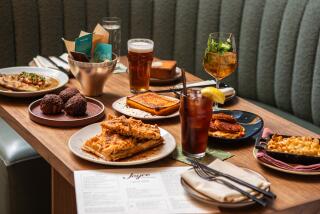The Decline of Prime
- Share via
Question: Was USDA Prime beef better two decades ago?
Answer: On the average, yes. Not too many years ago, 4.5% of beef carcasses that were quality-inspected by the USDA were awarded the Prime grade. (USDA officials looked for ample marbling; white fat; bright, fresh flesh color; and firm, fine flesh texture.) When the USDA lowered its grading standards in 1976, that percentage jumped to 6.5%--which means that approximately one-third of the beef being sold today as USDA Prime would have been stamped before 1976 with the next-lower grade classification, USDA Choice.
Even the USDA Choice designation isn’t what it used to be. That category once encompassed 54% of the carcasses; today it includes 68% of them. The increase is due to the inclusion of beef that prior to 1976 would have been given the third-level grade, USDA Good.
Q: Does yellow skin indicate a quality chicken?
A: In most areas of the country, a yellow skin used to be a worthwhile (though not 100% reliable) clue that the chicken was imbued with extra flavor and surface fat. If the chicken had a yellow skin, chances were it grew up bathed in the sun’s rays and enjoyed a nutritious diet, either by scratching for its subsistence around the farmhouse or by eating the right mix of foods tossed to it by its owner.
The validity of the yellow-skin criterion has been undermined during the last 20 years by some of the mass-marketing chicken farms. They add marigold petals or similar sources of gold, yellow or orange pigment to their feed formulas, and since the petals are natural, the companies are not legally forced to reveal their ruse to the shoppers.
Without the “colorful diet,” the chickens would probably have ghostly bluish-white skins because they seldom, if ever, leave their cramped, sunless indoor coops. The next time you view the golden chickens in the supermarket, think flowers, not sunshine.
Q: Why should I remove the roast from the oven slightly underdone?
A: Let’s say you want to cook the roast to 140 degrees and you leave it in the oven until it reaches that internal temperature. Although the middle of the roast may be 140 degrees, the meat near the surface is probably hot enough--around 160 to 180 degrees--to continue cooking the colder center while you are allowing the roast to rest before carving.
By the time the temperature equalizes throughout a thin cut of meat (under three inches at its minimum diameter or thickness), its interior temperature will have climbed about five degrees. The center of a medium-thick roast experiences roughly a 10-degree rise and the center of a roast more than 12 inches thick will rise around 15 degrees after the meat is removed from the oven. Those figures refer to meats cooked medium rare; the amount of rise will be about 10% less for rare roasts, 10% greater for medium and 15% higher for those that are well done.
Q: Why should a roast be brought to, or near, room temperature before cooking?
A: This is principally a precautionary measure against having the roast’s outside overcook and dry out before the inside is properly warmed and cooked. Also, since a room-temperature roast cooks more quickly than its colder counterpart, you save energy.
Of course, if the roast is about six inches or more thick, its surface will undergo bacterial contamination before the center of the meat reaches room temperature. An hour in the open should not pose a health threat unless the room is hot and humid.
When you cannot bring meat to room temperature, you should roast it at a temperature slightly lower than usual, for a slightly longer time. It’s less complicated (but also less effective) to extend the cooking time while maintaining the usual cooking temperature; if you remove a 6-inch-thick roast from the refrigerator and place it directly in a preheated 350-degree oven, add about 12 to 15 minutes to the cooking time.
If the roast is frozen, increase the original cooking time by about 50%. Naturally, the roast will not be as tasty and juicy, nor will its exterior be as attractive as a roast that was brought to room temperature before cooking.
If you have questions regarding meat, drop me a line; I’ll be happy to try to help: The Butcher, P.O. Box 907, Tiburon, Calif. 94920. Better yet, look for a copy of Howard Hillman’s “Kitchen Science” guide to fun and success in the kitchen. It’s published by Houghton Mifflin Co. and is a fascinating book. The above questions and answers are just a sample.
More to Read
Eat your way across L.A.
Get our weekly Tasting Notes newsletter for reviews, news and more.
You may occasionally receive promotional content from the Los Angeles Times.







